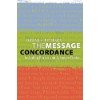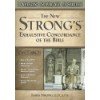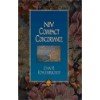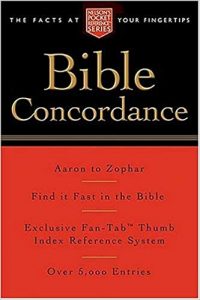A Bible concordance is a popular classic reference tool that Bible readers use to grow in their understanding of Old and New Testament teaching. In fact, concordances are so helpful that many Study Bibles now contain a concise version of the study aid as an appendix.
A concordance is study tool that contains an alphabetical A-to-Z listing of words found in the bible, as well as where they are located, by using book, chapter, and verse references.
Bible readers who desire more depth to their often keep a full-size concordance next to their personal Bible for easy access. The good news is that anyone can learn how to use a concordance to benefit their study of the Bible. So what exactly is a concordance?

Also see Bible Concordance vs Bible Dictionary: What’s the Difference? to learn more.
Bible concordances: examples
In full-length concordances, listings often supply several words of the context as well, so readers can get a sense of the subject matter of the verse and passage.
For example, under the listing for “courageous,” one of the uses is found in 1 Chronicles 28:20, and the concordance includes three words before “courageous” and four words after it:
“Be strong and courageous, and do the work.”
A full-length concordance, also called an exhaustive concordance, includes every word found in a particular translation, even words like “the,” “a,” and “to”.
The NIV Exhaustive Concordance lists 364,000 occurrences of words in categories like articles, prepositions, and conjunctions. If you are wondering, “the” occurs 55,728 times in the NIV, “a” occurs 9,144 times, and “to” occurs 20,933 times.
And yes, every chapter and verse is noted. This might be a good time to mention that exhaustive concordances are heavy books!
| Title | Cover | Browse |
|---|---|---|
| Cruden’s Complete Concordance |  | Amazon |
| ESV Exhaustive Concordance |  | Amazon |
| KJV Super Giant-Print Dictionary & Concordance |  | Amazon |
| The Message Concordance |  | Amazon |
| Nelson’s Foundational Bible Concordance |  | Amazon |
| The New American Bible, Concise Concordance |  | Amazon |
| The New Strong’s Compact Bible Concordance |  | Amazon |
| New Strong’s Concise Concordance of the Bible |  | Amazon |
| The New Strong’s Exhaustive Concordance of the Bible |  | Amazon |
| The New Strong’s Expanded Exhaustive Concordance of the Bible |  | Amazon |
| NIV Bible Concordance |  | Amazon |
| NIV Compact Concordance |  | Amazon |
| The NIV Exhaustive Bible Concordance |  | Amazon |
| Strong’s Concise Concordance and Vine’s Concise Dictionary of the Bible |  | Amazon |
| Strong’s Exhaustive Concordance, Updated Edition KJV |  | Amazon |
| The Strongest Strong’s Exhaustive Concordance |  | Amazon |
| The Strongest NASB Exhaustive Concordance |  | Amazon |
| Young’s Analytical Concordance to the Bible |  | Amazon |
Many people who use concordances also use Bible dictionaries? See What’s a Bible Dictionary? to learn more.
Concordance: details and features
The features of a typical entry in a concordance are easy to understand. The subject (e.g. “courageous”) is often is bold type, followed a number, which indicates the number of times the word occurs in Scripture, according to the particular translation.
The words various forms may be included in parantheses:
AARON (318) [Aaron’s, Aaronic]
Beneath this basic information are the list of occurrences organized according to book title, chapter and verse location, and a few words of context. Often, only the first letter of the subject is printed and the letter is in bold type.
Ex. 4:14 “What about your brother, A the Levite? 195
Ex. 4:27 The Lord said to A, “Go into the desert 195
Ex. 4:28 Then Moses told A everything 195
Some concordances provide an additional number (e.g. “195”) that corresponds with a Hebrew or Greek dictionary, also called a lexicon. If this is the case, the introduction to the concordance will explain what lexicon the numbers are associated with.
If someone looks up the number in the proper lexicon, they will be able to read the Hebrew or Greek definition of the word without having any knowledge of those languages.
Also see Reference Bible vs Study Bible: What’s the Difference? to learn more.
The History of Bible Concordances
The King James bible translation was published in 1611. The first concordance based on the KJV, called Robert Young’s Analytical Concordance to the Bible (links go to Amazon) was published in 1879.
Young’s concordance took 40 years of manual labor, three of which was just to create the typesetting.
Young’s was a significant accomplishment in the world of bible reference works, and immediately proved helpful to pastors in their ministry and bible readers who just wanted to study Scripture in more depth.
Strong’s Concordance
In 1894 another concordance was published that eventually became a classic. James Strong’s Exhaustive Concordance to the Bible — often referred to as “Strong’s” — was the result of three years of labor.
James Strong (1822-1894) was an American Methodist biblical scholar who oversaw the publication of the concordance.
Part of Strong’s uniqueness among concordances still today, which is a significant reason why it’s considered a classic, is because of its numbering system.
In Strong’s concordance, next to every English-language word, is a unique number that corresponds with the Hebrew or Greek word from which the English word is translated.
In the back of Strong’s concordance, original-language word definitions appear in numerical order. This feature enables people who don’t know Greek and Hebrew to look up and learn precise definitions.
In this way, Strong’s is more than just a concordance, that is an index of words, because it’s providing readers with information found in dictionaries.
The numbers are now known as “Strong’s numbers” and many bible reference books, including some commentaries and even other concordances, will list these numbers because so many readers own, or have access to, a Strong’s concordance.
Modern concordances
The Revised Standard Version (RSV) was published in 1952. The first concordance associated with it was published in 1988, called Eerdmans’ Analytical Concordance to the Revised Standard Version. In 2000, an updated edition was published, which aligns with the New Revised Standard Version (NRSV).

The New American Standard was published in 1971. The New American Standard Exhaustive Concordance of the bible appeared in 1981. Theologian Robert L. Thomas led 70 scholars who worked on the project. The concordance also lists Strong’s numbers.
The NIV translation was published in 1976, and while a few related concordances appeared in the years following, the most complete edition was published in 1983, called The NIV Exhaustive Concordance under Edward W. Goodrick and John R. Kohlenberger III. The concordance also lists Strong’s numbers.
The English Standard Version (ESV) was published in 2001. The ESV Exhaustive Concordance has 340,000 references to biblical words as well as complete lists for numerals found in Scripture.
Unique concordances
The New Strong’s Expanded Exhaustive Concordance of the Bible is the only concordance that includes the best of Vine’s Complete Expository Dictionary of Old and New Testament Words.
The publisher notes: “The Hebrew, Greek, and Aramaic dictionaries now have three times more word study information than any other edition. Plus additional cross-references from leading dictionaries make this the ultimate reference tool for pastors, teachers, and all students of the Bible.”
Other features include:
- The only Strong’s that includes Vine’s Complete Dictionary of Old and New Testament Words
- Words of Christ in red
- Complete topical index of the Bible
- Hebrew, Greek, and Aramaic dictionaries now have three times more word study information than any other edition
- Additional cross-references and word study helps from leading dictionaries
This resource combines two classics in one volume.
For readers who desire a concordance that is less expensive and lighter weight, The Pocket Bible Concordance is an option. While it doesn’t contain as many features as exhaustive concordances, there are still over 5,000 entries. Full-length concordances can be between 1,000-1,500 pages. This pocket concordance is 368 pages.
The New American Bible Revised Edition Concise Concordance aligns with the New American Bible (NAB) bible translation, which many Catholic readers utilize. Published in the early 1970’s, and revised in the early 1990’s, the NAB concordance includes words found in books that Protestant bible don’t include.
Take the Next Step
Tools that help people study the bible are invaluable. Concordances are a staple-resource to any bible reader’s library.
Whether someone is doing a word study, leading a bible study or small group, preaching or teaching, or just adding more depth to their devotional reading, concordances provide a fast yet accurate way to learn Scripture in obedience to 2 Timothy 2:15, “Be diligent to present yourself approved to God as a workman who does not need to be ashamed, accurately handling the word of truth.”
Also see What is a Chronological Bible?
Also see What Is a Bible Handbook?
Also see What Is a Bible Atlas?
Also see What is a Topical Bible? to learn more.
